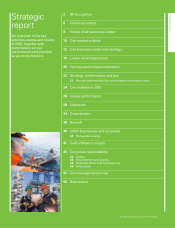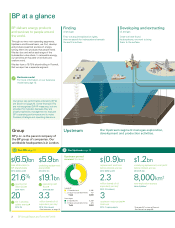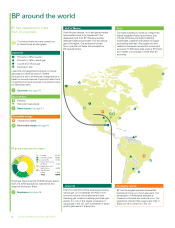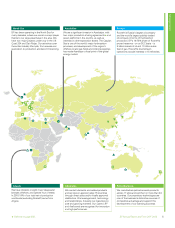BP 2015 Annual Report Download - page 14
Download and view the complete annual report
Please find page 14 of the 2015 BP annual report below. You can navigate through the pages in the report by either clicking on the pages listed below, or by using the keyword search tool below to find specific information within the annual report.
Our markets in 2015
See page 24 for information on oil and gas
prices in 2015.
Near-term outlook
The global economy continues to experience
weaker growth in the main developing
economies and slower than expected recovery
in the developed world. World gross domestic
product (GDP) is expected to grow by 2.8% in
2016, led by the OECD, but with significant
downside risks from emerging economies,
particularly commodity exporters.
After around four years of averaging about $100
per barrel, oil prices fell by nearly 50% in 2015.
Even as US production growth stalled and global
oil demand rebounded, a large increase in OPEC
production continued to push inventories higher.
Price declines continued into early 2016, with
daily prices reaching levels not seen since 2004.
Prices are expected to remain low at least
through the near term. And while we anticipate
supply chain deflation in 2016 and beyond, as
industry costs follow oil prices with a lag, this
will be a tough period of intense change for the
industry as it adapts to this new reality.
Long-term outlook
The world economy is likely to more than double
from 2014 to 2035, largely driven by rising
incomes in the emerging economies and a
projected population increase of 1.5 billion.
We expect world demand for energy to increase
by as much as 34% between 2014 and 2035.
This is after taking into account improvements in
energy efficiency, a shift towards less energy-
intensive activities in fast-growing economies,
governmental policies that incentivize lower-
carbon activity, and national pledges made at the
2015 UN climate conference in Paris.
There are more than enough energy resources
to meet this growing demand, but there are a
number of challenges.
We believe that a diverse mix of fuels and technologies will
be essential to meet the growing demand for energy and
challenges facing our industry.
Our market outlook
G
lobal energy consumption by region
(
billion tonnes of oil equivalent)
2035
18
16
14
12
10
8
6
4
2
1965 2000
Other ChinaOther Asia
OECD
Affordability
Fossil fuels are currently cheaper than
renewables but their future costs are hard to
predict. Some fossil fuels may become more
costly as the difficulty to access and process
them increases; others may be more affordable
with technological progress, as seen with US
shale gas. While many renewables remain
expensive, innovation and wider deployment are
likely to bring down their costs.
Supply security
Energy resources are often distant from the
hubs of energy consumption and in places
facing political uncertainties. More than half of
the world’s known oil and natural gas reserves
are located in just eight countries.
Sustainability
Fossil fuels – though plentiful and currently more
affordable than other energy resources – emit
carbon dioxide (CO2) and other greenhouse
gases (GHG) through their production and use in
homes, industry and vehicles. Renewables are
lower carbon but can have other environmental
or social impacts, such as high water
consumption or visual intrusion.
Effective policy
BP believes that carbon pricing is the most
comprehensive and economically efficient policy
to limit GHG emissions. Putting a price on
carbon – one that treats all carbon equally,
whether it comes out of a smokestack or a car
exhaust – would make energy efficiency more
attractive and lower-carbon energy sources,
such as natural gas and renewables, more cost
competitive. A carbon price incentivizes both
energy producers and consumers to reduce their
GHG emissions. Governments can put a price
on carbon via a well-constructed carbon tax or
cap-and-trade system.
For further detail on our projections of future
energy trends contained in this section,
please refer to BP Energy Outlook.
Source: BP Energy Outlook.
BP Annual Report and Form 20-F 201510
























